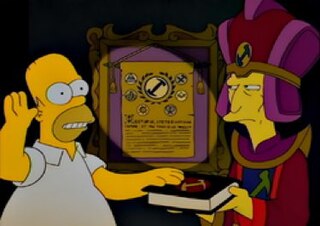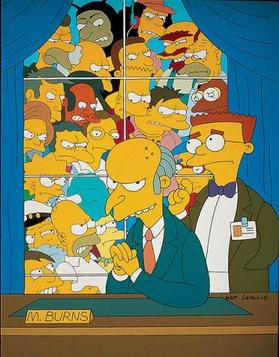
Abraham Jebediah "Abe" Simpson II, better known as Grampa Simpson, is a recurring character in the animated television series The Simpsons. He made his first appearance in the episode entitled "Grandpa and the Kids", a one-minute Simpsons short on The Tracey Ullman Show, before the debut of the television show in 1989.

"Homer the Great" is the twelfth episode of the sixth season of the American animated television series The Simpsons. It originally aired on the Fox network in the United States on January 8, 1995. In the episode, Homer joins an ancient secret society known as the Stonecutters.
"D'oh-in' in the Wind" is the sixth episode of the tenth season of the American animated television series The Simpsons. It first aired on the Fox network in the United States on November 15, 1998. In the episode, Homer Simpson travels to a farm owned by Seth and Munchie, two aged hippies who were friends with Homer's mother. After finding out his middle name is "Jay", Homer is drawn to the carefree lifestyle of hippies, and decides to become one himself.

"Treehouse of Horror IV" is the fifth episode of the fifth season of the American animated television series The Simpsons and the fourth episode in the Treehouse of Horror series of Halloween specials. It originally aired on the Fox network in the United States on October 28, 1993, and features three short stories called "The Devil and Homer Simpson", "Terror at 5+1⁄2 Feet", and "Bart Simpson's Dracula".

"Rosebud" is the fourth episode of the fifth season of the American animated television series The Simpsons. It first aired on the Fox network in the United States on October 21, 1993. In the episode, Mr. Burns misses his childhood teddy bear Bobo on the eve of his birthday. After flashbacks reveal Bobo's journey through history, the bear ends up in the hands of Maggie Simpson. Burns does everything in his power to get Bobo back.
"Lady Bouvier's Lover" is the twenty-first and penultimate episode of the fifth season of the American animated television series The Simpsons. It originally aired on the Fox network in the United States on May 12, 1994. In the episode, Abe Simpson falls in love with Marge's mother, Jacqueline Bouvier, and they start dating. However, on a night out in town, she is charmed by Mr. Burns. Abe is brokenhearted when he learns that Jacqueline is going to marry Mr. Burns.
"Homer Simpson in: 'Kidney Trouble'" is the eighth episode of the tenth season of the American animated television series The Simpsons. It first aired on the Fox network in the United States on December 6, 1998. In the episode Grampa's kidneys explode, leaving him in urgent need of a donor. His son Homer initially agrees to donate one of his kidneys, but after hearing of side effects of only having one kidney, he begins to have second thoughts about the operation.

"Homie the Clown" is the fifteenth episode of the sixth season of the American animated television series The Simpsons. It originally aired on the Fox network in the United States on February 12, 1995. In the episode, Homer becomes a Krusty the Clown impersonator, but is mistaken for the real Krusty by the Springfield Mafia. Joe Mantegna returned as Fat Tony, while Dick Cavett and Johnny Unitas guest starred as themselves.
"Bart Gets an Elephant" is the seventeenth episode of the fifth season of the American animated television series The Simpsons. It originally aired on the Fox network in the United States on March 31, 1994. In this episode, Bart wins a radio contest and is awarded a full-grown African elephant that he names Stampy. After Stampy wrecks the Simpsons' house and eats all the food, Homer decides to sell Stampy to an ivory dealer. Bart runs away with Stampy to save his pet, but the family finds the two at a museum exhibit, where Homer sinks into a tar pit. Homer is saved by Stampy, and so gives the elephant away to an animal refuge instead.
"Lemon of Troy" is the twenty-fourth and penultimate episode of the sixth season of the American animated television series The Simpsons. It originally aired on the Fox network in the United States on May 14, 1995. In the episode, the children of Springfield try to retrieve their beloved lemon tree after it is stolen by the children of Shelbyville.

"Lisa vs. Malibu Stacy" is the fourteenth episode of the fifth season of the American animated television series The Simpsons, and the 95th episode overall. It originally aired on the Fox network in the United States on February 17, 1994. Lisa challenges the Malibu Stacy dollmakers to make a less sexist doll. With Malibu Stacy's original creator, Stacy Lovell, Lisa creates the doll Lisa Lionheart to positively influence young girls.
"The Front" is the nineteenth episode of the fourth season of the American animated television series The Simpsons. It originally aired in the United States on the Fox network on April 15, 1993. In the episode, Bart and Lisa decide to write an episode of The Itchy & Scratchy Show; after their script is rejected, they resubmit it under the name of their grandfather Abraham Simpson, resulting in Grampa being hired as a staff writer. Meanwhile, Homer returns to high school to retake a failed science course.
"Bart the Murderer" is the fourth episode of the third season of the American animated television series The Simpsons. It originally aired on the Fox network in the United States on October 10, 1991. In the episode, Bart stumbles upon a Mafia club after having bad luck at school. The owner of the bar, mobster Fat Tony, hires Bart as a bartender. When Principal Skinner goes missing after punishing him at school, Bart is put on trial for his murder.
"Old Money" is the seventeenth episode of the second season of the American animated television series The Simpsons. It originally aired on the Fox network in the United States on March 28, 1991.
"Marge on the Lam" is the sixth episode of the fifth season of the American animated television series The Simpsons. It originally aired on the Fox network in the United States on November 4, 1993. After Marge invites her neighbor Ruth Powers to attend the ballet, they become friends. Homer grows jealous of their friendship and pursues them, resulting in a police chase led by Chief Wiggum that ends in near-disaster.
"The War of the Simpsons" is the twentieth episode of the second season of the American animated television series The Simpsons. It originally aired on the Fox network in the United States on May 2, 1991. In the episode, Homer gets drunk at a dinner party and embarrasses Marge, so she enrolls them in marriage counseling at a lakeside retreat with Reverend Lovejoy.
"Bart's Comet" is the fourteenth episode of the sixth season of the American animated television series The Simpsons. It originally aired on the Fox network in the United States on February 5, 1995. In the episode, Bart Simpson accidentally discovers a comet, which is heading towards Springfield. The show's writing staff saw an issue of Time magazine that presented the threat of comets hitting Earth on its cover, and decided to create an episode in a similar vein. "Bart's Comet" contains references to Where's Waldo? and The Twilight Zone, and received positive reviews.
Media is a recurring theme of satire on The Simpsons. The show is known for its satire of American popular culture and especially television culture, but has since its inception covered all types of media such as animation, journalism, commercials, comic books, movies, internet, and music. The series centers on a family and their life in a typical American town but the town of Springfield acts as a complete universe. The town features a vast array of media channels—from kids' television programming to local news, which enables the producers to make jokes about themselves and the entertainment industry.

The sixth season of the American animated television series The Simpsons originally aired on the Fox network between September 4, 1994, and May 21, 1995, and consists of 25 episodes. The Simpsons is an animated series about a working class family, which consists of Homer, Marge, Bart, Lisa, and Maggie. The show is set in the fictional city of Springfield, and lampoons American culture, society, television and many aspects of the human condition.

"Who Shot Mr. Burns?" is a two-part episode of the American animated television series The Simpsons.Part One is the twenty-fifth and final episode of the sixth season and originally aired on the Fox network in the United States on May 21, 1995, while Part Two is the season premiere of the seventh season and aired on September 17, 1995.









